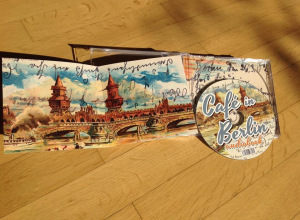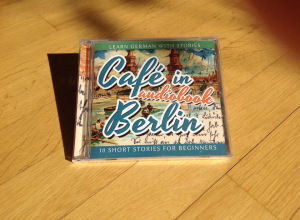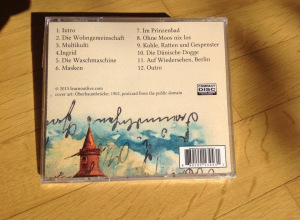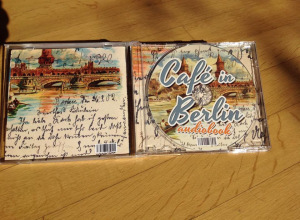André Klein's Blog, page 13
June 25, 2015
Alberto: “The teacher has an important role, but the primary role belongs to the student.”
The following interview is part of an interview series in which we feature education professionals from a variety of different fields in order to highlight individual efforts and creative solutions to education in the 21st century. If you want to participate simply write down and send your answers to the five below questions to info {at} learnoutlive.com and include a picture of yourself. (Please note that we reserve the right to not publish all submissions)
 1. Who are you and what do you do in education?
1. Who are you and what do you do in education?My name is Alberto, and I am the co-founder of ayaespanol.com, a website that provides personalized Spanish language lessons and courses, and free resources to learn Spanish.
I hold a degree in Philosophy and a Masters in teaching Spanish and English as foreign languages. I have taught Spanish abroad in public universities and high schools, and English in private language schools. When I began teaching I did not know if I could enjoy this profession. I do not believe teaching is a vocation. I believe it is vocational, as in something you can train people to do. I think enthusiasm for professional improvement is crucial in becoming a good teacher.
After many years living abroad, my partner and I decided to develop a website to teach Spanish online and we worked very hard on every detail for over a year. We launched the website only a few months ago, right after moving back to Spain. The idea that prompted us to build the website was to be able to do what we love in the place of our choice. So far we are very happy with the decision and how things are going. We are teaching students from China and Europe and enjoying our lives by the seaside.
We strongly believe in autonomous learning and the teacher as a guide. Our students set their learning goals and we motivate and guide them to find the best way to achieve those goals. The teacher has an important role, but the primary role belongs to the student.
2. Describe a typical work day in your life!We usually work in the mornings, but our timetable has to be flexible in order to be able to cope with the lessons and different tasks that we set up for the day. We try to be very organized, it is the only way to be productive and to find some time for ourselves and for our hobbies.
A typical work day in our lives is spent teaching, preparing lessons, answering emails, creating or editing materials, posting in Facebook, uploading videos to our YouTube channel… An independent teacher has no time for sorrow! : )
In my free time, I enjoy swimming in the sea, playing guitar, reading and watching movies.
3. In what way has technology in general and the net, in particular, changed your work?Before starting to teach online, technology already had quite an impact in the way I prepared and delivered my lessons. I have been using the net for years to find information, resources, and inspiration to make my lessons more motivating, and when possible I have always made use of the Internet in the classroom.
Nevertheless, teaching online has changed my work in many other ways. Since we provide one to one personalized lessons and courses, nowadays I do not see myself as a language teacher but as a tutor. Teaching to ten, fifteen, thirty or even fifty students has very little in common with tutoring a single student. Personalized teaching is only possible with small groups or one to one lessons.
Teaching online has other advantages like using digital textbooks, video tutorials, and the recording of the lessons to give feedback. In general both technology and the net have made my work more exciting and enjoyable, however, sometimes I spend more time than I would like seated in front of the computer.
4. What challenges do you see for education in the future?For teachers, help students develop a sense of ownership over the learning process and fostering autonomy in the classroom are two of the biggest challenges today and in the future.
From my personal experience and from what I have learned from other teachers, I can say that the roles within the classroom have not changed much in the last years, or have changed at a very slow pace. In most educational institutions, students are still very passive and are seen by their teachers as not ready to play the prominent role needed to become autonomous learners. Teachers do not put enough emphasis on learner autonomy because they feel threatened regarding their status or do not feel comfortable playing new and more challenging roles.
Hopefully, more teachers will see the need for change in foreign language education and will find new ways to motivate and involve students in their learning process.
5. Where can we find you online?Website: ayaespanol.com
Blog: ayaespanol.com/normal-blog/
Facebook: facebook.com/pages/ayaespanolcom/1374226442883936
Youtube: https://www.youtube.com/channel/UCRe3_JuhUfyjkQ4GTO7XXkQ
–

 About the author:
LearnOutLive Interviews is an interview series in which we feature private teachers and education professionals from a variety of different fields in order to highlight individual efforts and creative solutions to education in the 21st century. If you want to participate simply write down and send your answers to these five questions to info {at} learnoutlive.com and include a picture of yourself. (Please note that we reserve the right to not publish all submissions)
About the author:
LearnOutLive Interviews is an interview series in which we feature private teachers and education professionals from a variety of different fields in order to highlight individual efforts and creative solutions to education in the 21st century. If you want to participate simply write down and send your answers to these five questions to info {at} learnoutlive.com and include a picture of yourself. (Please note that we reserve the right to not publish all submissions)
The post Alberto: “The teacher has an important role, but the primary role belongs to the student.” appeared first on Learn Out Live!.





June 21, 2015
Why You Should Learn the Language Before Living it

photo by unsplash
Language learners across the world claim that completely immersing themselves in the language is exactly what helped them become fluent. This kind of story is quite common, but what exactly makes one person more successful at learning a language than another person? There are plenty who have tried to move to another country with hopes of becoming fluent in another language only to be stuck at the beginner level for many years. So, why does this happen, and how can we avoid getting stuck at the beginning?
3 basic beliefs on how languages are learntWell, to begin, let’s look at 3 basic beliefs on how languages are learnt. The first belief talks about students developing a habit by repeating the language; somehow, this would help them learn the language. The second belief is that people can figure out and learn the language without much instruction; all they need is to be exposed to the language. The third belief is more open so that it can include bits and pieces of many other theories out there; it focuses on a need to make the learner focus on form and meaning. Whether these beliefs are right or wrong doesn’t matter, however, the third belief has been more effective at helping adults become fluent in a second language than the first two.
As adults, our minds process information in a different way than children. Adults have a stronger understanding of form in their language compared to young children. This understanding of form is the reason adults can create more complex expressions than kids. Now, if we move away from someone’s native tongue and give them a second language, they will need to learn some form in order to become an advanced speaker.
Adults can easily become fluent in a language by using the basics that they pick up while being immersed, but according to Elizabeth Bernhardt who is the Director of the Stanford Language Center at Stanford University, when students only focus on meaning and not form “…the language [they have] at the end is fairly sloppy and limited”. Thus to become an advanced and fluent speaker, adults need to focus on form.
Taking a language course or studying the language by oneself should be priority number one, even before considering immersion. Without a basic understanding of the bits and pieces that form the structure of a language, learners will have great difficulty advancing in the language.
Building Foundations …In addition to that, studying the language before immersion allows the student to notice things that they’ve learnt while being immersed. This ability to notice features of a language has been documented as a really important part of language learning. Being able to notice features in the language, when others use them, will help the student understand how it’s used which will help them use it on their own.
Another, perhaps more obvious, benefit to studying the language before travelling is that you’ll actually be able to use what you already know and improve on it. Learning a language can be compared to building a castle, if you’ve started building the foundation of a castle one year before your friend, you’ll most likely finish building your castle 1 year before your friend too. If you travel to a new country with a basic understanding of the language, you can get ahead much faster than those who need to spend their few months learning the basics.
Given these points, one should consider immersion as one of the best ways to learn a language. Just be mindful before your trip so that you can the most out of it, learn about the culture, and improve your language skills faster than ever.
–
You’ve been reading a guest post by Leean Downes

Leeann Downes is an unconventional English teacher, tutor, and language coach who has a passion for combining education and technology. She has designed her own website, and is always in the midst of creating and combining software for the purposes of second language acquisition. Her personality includes a few spoon fulls of geek, a table spoon of adventure, and a pinch of princess, so not only does she keep updated about language learning, but she also combines every other aspect of life in her work. When she is not crafting a lesson, creating web-based learning activities, or getting lost in mountains of digital research, she can be found writing on her own blog or playing an MMORPG somewhere. You can get in touch on Google+ or by email.

 About the author:
Leeann Downes is an unconventional English teacher, tutor, and language coach who has a passion for combining education and technology. She has designed her own website, and is always in the midst of creating and combining software for the purposes of second language acquisition. Her personality includes a few spoon fulls of geek, a table spoon of adventure, and a pinch of princess, so not only does she keep updated about language learning, but she also combines every other aspect of life in her work. When she is not crafting a lesson, creating web-based learning activities, or getting lost in mountains of digital research, she can be found writing on her own blog or playing an MMORPG somewhere. You can get in touch on Google+ or by email.
About the author:
Leeann Downes is an unconventional English teacher, tutor, and language coach who has a passion for combining education and technology. She has designed her own website, and is always in the midst of creating and combining software for the purposes of second language acquisition. Her personality includes a few spoon fulls of geek, a table spoon of adventure, and a pinch of princess, so not only does she keep updated about language learning, but she also combines every other aspect of life in her work. When she is not crafting a lesson, creating web-based learning activities, or getting lost in mountains of digital research, she can be found writing on her own blog or playing an MMORPG somewhere. You can get in touch on Google+ or by email.
The post Why You Should Learn the Language Before Living it appeared first on Learn Out Live!.





May 31, 2015
8 German Graphic Novels To Boost Your German Learning
We’ve already talked about using German comics to make learning the language more fun and accessible. Today, I’d like to share a few German graphic novels with you. And in case you’re wondering what the difference is: graphic novels are generally much longer than single comic issues and deal with more complex topics, usually over the course of one or two books, whereas a comic tends to sprawl over a complete series.
Having said that, let’s look at a few German graphic novels:
1. Wormworld Saga
image: wormworldsaga.com
Jonas is a dreamer. Spending the holidays in the countryside with his grandmother he discovers a strange picture on the attic which turns out to be a portal to a different reality, the Wormworld.
 Created by German artist Daniel Lieske, the Wormworld Saga is a crowd-funded project which can be read online for free in multiple languages, which is just perfect for German learners, since you can have the German version open on one screen or device, and the English (or French, Spanish, etc.) version on another one.
Created by German artist Daniel Lieske, the Wormworld Saga is a crowd-funded project which can be read online for free in multiple languages, which is just perfect for German learners, since you can have the German version open on one screen or device, and the English (or French, Spanish, etc.) version on another one.
 Free online reading
Free online reading
2. Kafkas Verwandlung

image: book2look
Maybe you’ve toyed with reading Kafka’s Metamorphosis in the original German version but shied away from it due to the language. Don’t despair! Now you can start gaining access to this classic piece of German literature by reading the graphic novel, panel by panel.
 Created by Eric Corbeyran and Richard Horne, this graphic novel is a very faithful adaptation of the original German text and the drawings tastefully and innovatively create the right atmosphere. It was published in 2010 by Knesebeck.
Created by Eric Corbeyran and Richard Horne, this graphic novel is a very faithful adaptation of the original German text and the drawings tastefully and innovatively create the right atmosphere. It was published in 2010 by Knesebeck.
3. Wir können ja Freunde bleiben

image: Reprodukt
 This graphic novel (“We can still be friends …”) by German artist Mawil is a humorous portrait of early relationships and life in an East-German “Plattenblausiedlung” (prefab housing project) and was published by Reprodukt.
This graphic novel (“We can still be friends …”) by German artist Mawil is a humorous portrait of early relationships and life in an East-German “Plattenblausiedlung” (prefab housing project) and was published by Reprodukt.
 Free preview via Reprodukt
Free preview via Reprodukt
4. Antoinette kehrt zurück

image: Egmont
 German ex-pat Antoinette lives and works in Los Angeles as a Creative Director of an advertising agency, and although she has sworn never to return to Germany she still finds herself staring at her little home village through a web-cam. Eventually she has to return and relive the painful experiences that prompted her to leave her birthplace in the first place.
German ex-pat Antoinette lives and works in Los Angeles as a Creative Director of an advertising agency, and although she has sworn never to return to Germany she still finds herself staring at her little home village through a web-cam. Eventually she has to return and relive the painful experiences that prompted her to leave her birthplace in the first place.
 Free preview via Egmont
Free preview via Egmont
5. Hotel Hades

image: Egmont
When snack-bar owner Peter, author Martha and her lover Florian are shot at the same time, they find themselves on a strange journey through a bureaucratic Beyond where they struggle to make ends meet and perhaps find their way into paradise after all.
 The artist Katharina Greve was born in Hamburg and this graphic novel was published by the Egmont group as well.
The artist Katharina Greve was born in Hamburg and this graphic novel was published by the Egmont group as well.
 Free preview via Egmont
Free preview via Egmont
6. Gleisdreieck: Berlin 1981

image: spiegel.de
This atmospheric and meticulously researched graphic novel by Jörg Ulbert (text) and Jörg Mailliet (drawings) takes place in Cold War Berlin, 1981, where a terrorist and a policeman are playing a dangerous cat and mouse game.
 First published in France by “Des ronds dans l’O” in 2014, the German edition was published in April 2015 by the Berlin Story Verlag.
First published in France by “Des ronds dans l’O” in 2014, the German edition was published in April 2015 by the Berlin Story Verlag.
 Free preview via Berlin Story Verlag
Free preview via Berlin Story Verlag
7. Herr Lehmann

image: bic-media.com
Based on the novel by Sven Regener with the same title, which has also been turned into a critically acclaimed film, Herr Lehmann portrays life in West Berlin, shortly before the wall came down. The rough and charming little world around the protagonist Frank Lehmann is full of funny bar encounters and strange characters that couldn’t have existed anywhere else.
 Drawn by Tim Dinter, this German graphic novel was published by the Eichborn Verlag in 2014.
Drawn by Tim Dinter, this German graphic novel was published by the Eichborn Verlag in 2014.
 Free preview via bic-media
Free preview via bic-media
8. Treibsand: Eine Graphic Novel aus den letzten Tagen der DDR

image: tagesspiegel.de
When foreign correspondent Tom Sandmann is sent to Berlin to report on the riots, accompanied by bad dreams and a horrible toothache, he witnesses the downfall of the “German Democratic Republic”
 “Treibsand” (quick sand) was written by Alexander Lahl and Max Mönch, drawn by Kitty Kahana and published by Metrolit in 2014.
“Treibsand” (quick sand) was written by Alexander Lahl and Max Mönch, drawn by Kitty Kahana and published by Metrolit in 2014.
–

 About the author:
André Klein was born in Germany, has grown up and lived in many different places including Thailand, Sweden and Israel. He has produced two music albums, performed and organized literary readings, curated an experimental television program and is the author of various short stories and non-fiction works.
About the author:
André Klein was born in Germany, has grown up and lived in many different places including Thailand, Sweden and Israel. He has produced two music albums, performed and organized literary readings, curated an experimental television program and is the author of various short stories and non-fiction works.
The post 8 German Graphic Novels To Boost Your German Learning appeared first on Learn Out Live!.





May 22, 2015
Bored? Uninspired? Learn A New Language And Be Happy All The Time

photo by unsplash
Everyone who has ever seriously tried to learn a new language knows that it is hard work. Perhaps the best proof for this simple fact is the onslaught of shady offers with promises like: “The Secret Method Nobody Wants You To Know! Learn German in 10 Days!” – “Master Japanese in Your Sleep!” – “With Patented Snake Oil 3000™”
Let’s be honest for a second, okay? There are no silver bullets, no well-kept secrets or shortcuts to learning a language. It takes some serious time and effort. You can literally invest yourself infinitely in any given language. But here’s the thing. The payoffs are equally limitless!
Reclaim Your Childlike Wonder & CuriosityHave you ever observed a child making its first steps on the beach, gazing at the sun, marveling at the beauty and indescribable wonder of it all? We all used to be like that once. But then we learned the names for things, labeled sun, moon and stars, and put everything into neatly categorized boxes.
By learning a language we can tap into that same sense of wonder and curiosity again. Especially when we find ourselves in a foreign country, whether for just a few weeks or months.
For example, I still remember when I first started to learn how to read as a child. Riding on a tram through the city, I couldn’t take my eyes off all the shop-signs, pestering my grandmother with a stream of never-ending questions like: “What does it say here?” – “Pets-hop?”- “What is a Far-macee?” – “Why do you spell Candy with C and not with K?”
Now, many decades later I find myself in the exact same spot, walking through streets in Israel, each street-sign and shop window full of strange letters and words, vowel-less riddles just waiting to be cracked. And when a jumble of letters suddenly resolves to a word (from right to left, mind you), understanding comes like lightning and the connections flare up in a happy moment of: “Oh! So that’s what that means!”
That Sweet Sense of AchievementWe don’t usually appreciate all the many little things we do in the course of a single day. We make phone calls, write emails, fill out forms and brush off salesmen at our door. It’s all part of the hum-drum of day-to-day reality. It’s certainly no cause for excitement or happiness! We just … get it done.
But when you’re a foreigner in a foreign land, each one of these little things can quickly become a hurdle, especially when you don’t switch to a bridging-tongue like English to escape the sense of discomfort:
Somebody calls you on the phone and you just asked them three times to repeat what they have said. Have you won in the lottery or is somebody trying to sue you? Should you ask again just to be sure? How do you write a quick business email confirming an agreement or meeting? Is that really the right closing? Should you google it again just to be on the safe side? What does this field say in this form? The dictionary doesn’t seem to make any sense. And just how do you tell the salesman that you aren’t interested without sounding too rude or even accidentally egging him on?
As discomforting as these experiences may be, when you manage to make yourself understood, each minute exchange like that can bring a great sense of achievement. You navigated through the maze of a foreign-language automated phone system? You are a genius! You filled out a simple online form to to change your mobile plan? Wow! It worked! Told a sales rep that you aren’t interested in an upgrade? You’re on top of the world!
Whereas a native will just breeze through all of this, a language learner can get stuck everywhere or turn each moment into an opportunity for growth and happiness!
Learning As A Lifestyle, Not A Means to an EndLearning a new language puts a person into a humble place. You can’t talk and act as fast as people around you. You often feel stupid and inadequate. Superficially speaking, your (often futile) attempts to come to grips with it all may be seen as a handicap. But these moments can teach us to look at life in a different way. We may even develop empathy for others who — for whatever reason — are struggling with the most simple tasks from day to day.
Ultimately, experiencing these moments of discomfort and achievement may lead to the sense that life is not just about functioning well and getting things done, but about constantly growing, learning, keeping open to new experiences and never giving up.
–

 About the author:
André Klein was born in Germany, has grown up and lived in many different places including Thailand, Sweden and Israel. He has produced two music albums, performed and organized literary readings, curated an experimental television program and is the author of various short stories and non-fiction works.
About the author:
André Klein was born in Germany, has grown up and lived in many different places including Thailand, Sweden and Israel. He has produced two music albums, performed and organized literary readings, curated an experimental television program and is the author of various short stories and non-fiction works.
The post Bored? Uninspired? Learn A New Language And Be Happy All The Time appeared first on Learn Out Live!.





May 18, 2015
An Epic Fantasy Adventure For German Learners (PDF, EPUB, MOBI)

If you’re subscribed to our German ebooks newsletter, you might have heard about it already: our epic interactive fantasy trilogy for German learners is finally complete!
To celebrate the completion of this trilogy which was two years in the making, the first episode, Genowrin, is now available as a free download for a limited time (offer expired) for everyone who’s interested.
What is it about?After a long and terrible war a warrior returns home, but nothing is as he remembers. The kingdom is haunted by a dark curse. Can you find out what happened and restore peace and glory?

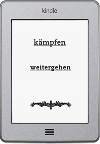 Read the story like any other book, until you reach an action point. There, you can decide what happens next. During battles and quests you’ll be asked questions. If you answer correctly, the story continues. Got it wrong and died? Just hit “back” and try again!
Read the story like any other book, until you reach an action point. There, you can decide what happens next. During battles and quests you’ll be asked questions. If you answer correctly, the story continues. Got it wrong and died? Just hit “back” and try again!
Don’t worry. You got infinite lives 
And since this is all about learning new words, the more you repeat a scene, the better!
In this video I show the book on an older non-touch Kindle device. Of course, the whole thing is even more fun when you load it onto your iPad, smartphone or a newer Kindle with touch-based input.
Is this a good book for beginners?The story is aimed at intermediate and advanced learners, but if you use a dictionary on your Kindle, iPad or Android phone, even beginners will benefit from this unique German learning adventure. Need help with that? See here.
–

 About the author:
André Klein was born in Germany, has grown up and lived in many different places including Thailand, Sweden and Israel. He has produced two music albums, performed and organized literary readings, curated an experimental television program and is the author of various short stories and non-fiction works.
About the author:
André Klein was born in Germany, has grown up and lived in many different places including Thailand, Sweden and Israel. He has produced two music albums, performed and organized literary readings, curated an experimental television program and is the author of various short stories and non-fiction works.
The post An Epic Fantasy Adventure For German Learners (PDF, EPUB, MOBI) appeared first on Learn Out Live!.





An Epic Fantasy Adventure For German Learners (free download)

If you’re subscribed to our German ebooks newsletter, you might have heard about it already: our epic interactive fantasy trilogy for German learners is finally complete!
To celebrate the completion of this trilogy which was two years in the making, the first episode, Genowrin, is now available as a free download for a limited time for everyone who’s interested.
What is it about?After a long and terrible war a warrior returns home, but nothing is as he remembers. The kingdom is haunted by a dark curse. Can you find out what happened and restore peace and glory?

 Read the story like any other book, until you reach an action point. There, you can decide what happens next. During battles and quests you’ll be asked questions. If you answer correctly, the story continues. Got it wrong and died? Just hit “back” and try again!
Read the story like any other book, until you reach an action point. There, you can decide what happens next. During battles and quests you’ll be asked questions. If you answer correctly, the story continues. Got it wrong and died? Just hit “back” and try again!
Don’t worry. You got infinite lives 
And since this is all about learning new words, the more you repeat a scene, the better!
In this video I show the book on an older non-touch Kindle device. Of course, the whole thing is even more fun when you load it onto your iPad, smartphone or a newer Kindle with touch-based input.
Is this a good book for beginners?The story is aimed at intermediate and advanced learners, but if you use a dictionary on your Kindle, iPad or Android phone, even beginners will benefit from this unique German learning adventure. Need help with that? See here.
–

 About the author:
André Klein was born in Germany, has grown up and lived in many different places including Thailand, Sweden and Israel. He has produced two music albums, performed and organized literary readings, curated an experimental television program and is the author of various short stories and non-fiction works.
About the author:
André Klein was born in Germany, has grown up and lived in many different places including Thailand, Sweden and Israel. He has produced two music albums, performed and organized literary readings, curated an experimental television program and is the author of various short stories and non-fiction works.
The post An Epic Fantasy Adventure For German Learners (free download) appeared first on Learn Out Live!.





April 23, 2015
5 Ways To Learn German With Spotify

photo by Audio-Technica via Flickr (CC BY 2.0)
Spotify is a well-known music subscription service, popular for its huge catalog and user-curated playlists. But did you know that it can also be a great tool for learning German? Even with a free account (advertising-based) you can use the following 3 tips to learn German with Spotify.
1. Listen To German Music: Browse, Explore & Discover! Languages are embedded in culture. Whenever you learn a new language, you gain access to a whole new world of cultural expression. This is why our first suggestion is to just browse through German-language music until you find something you like. That’s actually really important! Because if you can groove to it, learning the words gets so much easier. But where to start?
Languages are embedded in culture. Whenever you learn a new language, you gain access to a whole new world of cultural expression. This is why our first suggestion is to just browse through German-language music until you find something you like. That’s actually really important! Because if you can groove to it, learning the words gets so much easier. But where to start?
You could just browse through a listing of German artists on Wikipedia by Genre and learn about different musical and cultural movements at the same time, then look the artists up on Spotify.
If you’d rather start out by listening than reading, YouTube can be a great spring board for initial discovery. For example. Herr Antrim has built a massive list of more than 300 German songs on Youtube. Listen, skip, get inspired by “related videos” and then delve deeper into an artist’s catalog on Spotify.
Of course you can also find playlists with German music directly on Spotify. The Goethe institute for example has a playlist with 50 German pop songs. But there are many others, as well. Some artists and genres are probably better for language learning than others, but again, most important is that you like the music.
2. Improve Your Vocabulary With LyricsOnce you’ve found an artist or song you like, you can use Spotify’s new lyrics function to read and sing along. Simply click the “lyrics” button in your Spotify desktop application, and before you know it, you’ll be jumping around and singing along in German!

listening to “Universal Tellerwäscher” by “Die Sterne”
As a strategy for learning German with lyrics, I’d recommend to first listen to a song without worrying too much about grammar and vocabulary. Then, as a second step, you could pause on certain phrases, look up unknown words and idioms and note them down for further study, e.g. in a vocab training or flashcard app. Or perhaps you’d just like to memorize a song’s words and melodies first, then return for deeper analysis? Feel free to experiment and see whatever approach works best for you
3. Listen To German Courses on SpotifySo, Spotify is well-known for music, but did you know that they have many language learning courses as well? Just search for “learn German” and start going through German audio learning programs, which may prove especially helpful for absolute beginners!

Intermediate and advanced students may find German audiobooks a pleasant way to expand vocabulary and improve listening comprehension. Just search Spotify for Hörbuch (audiobook) or take a look at this dedicated German audiobook profile:

Last but not least, many German comedians (yes, German humor exists) have some of their catalog available on Spotify. Again, it depends a lot on personal taste, but here are a few examples: Loriot, Helge Schneider, Otto Waalkes, Heinz Erhardt and Badesalz all are on Spotify.

-

 About the author:
André Klein was born in Germany, has grown up and lived in many different places including Thailand, Sweden and Israel. He has produced two music albums, performed and organized literary readings, curated an experimental television program and is the author of various short stories and non-fiction works.
About the author:
André Klein was born in Germany, has grown up and lived in many different places including Thailand, Sweden and Israel. He has produced two music albums, performed and organized literary readings, curated an experimental television program and is the author of various short stories and non-fiction works.
The post 5 Ways To Learn German With Spotify appeared first on Learn Out Live!.





March 11, 2015
Compact Discs From The Cloud: A Story Of Lasers and Ink

Yes, that’s a CD version of the Café in Berlin audiobook. Skip to the end of this article to find out more.
Once Upon a Time …
It’s now almost 20 years ago since my friend Nico (aka Thunder) and I released our first music album of painstakingly programmed beats and harmonies. It was a time when computers were still bulky beige boxes and the chirpy sounds they emitted were a far cry from the high definition audio of modern bedroom studios.
Undeterred by unwieldy software and lo-fi sounds we pressed on, mashing up samples and self-recorded voices full of static into beats, bars and tracks.
Once we had scraped together a number of these “songs”, we decided we put together an album, cramming as many tunes as possible into the 80 minute limit and revising the track listing on crumpled napkins. Since neither of us owned a computer with a CD burner yet, we asked a friend to shlep his superior machine over to my parents’ house where we spent a whole night with the repetitious but exciting process of feeding a blank disk to the tray, waiting somewhere between half an hour to an hour and then removing the finished audio CD which was still warm from the laser. Insert, burn, rinse and repeat! It was like baking bread! Digital, audible, laser-baked bread!
In fact, it was so much fun that we totally forgot ourselves and only later realized that we’d created far more CDs than we’d ever be able to sell. In the spur of the moment we threw together a crude cover-design and proceeded to print it over and over again, until at least one of the ink cartridges went dry and each new batch had increasingly weird color combinations.
And then we were suddenly done.
We had created our own CD! But what next?
Spamming The Public Airwaves

photo by Junglecat via WikiCommons (CC BY-SA 3.0)
Why, of course! We needed to bring it to market. But instead of writing begging letters to record companies we decided to try our own luck. Mind you, this was a time before every home had even dial-up internet access, before the “Check my album, yo!” messages on MySpace, before forum-spam and self-promoting twitterbots.
In fact, we didn’t even have ICQ or AOL instant messenger yet. But we had something else: amateur radio! Yes that’s right, as weird as it may sound to the always-connected world of today, my friends and I each had a small transceiver box connected to a little antenna over which we exchanged the usual teenage inanities nowadays found on Facebook or WhatsApp.
Very soon we found ourselves peddling our new album to each and every person we encountered on the public airwaves. It was the equivalent of spamming your email-contacts and social media timelines. We had created our own music album, and the world had to know about it!
Carefully put, most people were not as excited about the release of our first music album as we were and we probably broke a couple of unspoken ham radio rules in the progress. However, we actually sold one CD like this! I don’t recall the radio operator’s name, but I do remember that she was a girl (most of the amateur radio community, not unlike early computer communities, was predominantly male) and that we met up at the local trainstation where we actually sold our first album entitled “Selfmade Shit” for 5 Deutschmark.
I don’t think that we ever sold another album after that, not via amateur radio or in any other way. Also, I don’t know what happened to all the other CDs. To the best of my knowledge, all recordings of this time have been lost. But I do know that the excitement of composing, manufacturing and marketing our first music album was never to be surpassed.
On-Demand Printing
Enter 2014, and the world of audio is all about streaming. People don’t even purchase MP3s that often anymore. Everything is instant, always-on, in the cloud. And yes, Nico and I also published our latest release in 2008 digital-only. Last year I created an audiobook for German learners which also exists only as a download or stream.
Don’t get me wrong, I think this new world of Spotify, iTunes and Soundcloud is great! Everybody can quickly publish and even sell their works to a world-wide audience. But sometimes I miss these nights of laser-baking and cutting covers just right to fit the tray.
This is why I got very excited when I recently, discovered that CreateSpace, an Amazon service broadly known for its on-demand printing of self-published books, also does CDs!
I don’t know if people still listen to CDs but I just had to create one anyway, just for the fun of it. It’s not quite finished yet, but here are a few photos of the first draft of the CD version of the above-mentioned audiobook:
I didn’t have to deal with blank CDs, didn’t print, cut or glue anything. I simply uploaded the audio and artwork and now, whenever somebody orders a copy, it gets printed and shipped.
It’s clean, fast, and a somewhat magical process in its own right.
Interested in a copy? Sign up for our newsletter to hear when it’s ready, or keep checking this post for updates.
-
photos by Albert Klein

 About the author:
André Klein was born in Germany, has grown up and lived in many different places including Thailand, Sweden and Israel. He has produced two music albums, performed and organized literary readings, curated an experimental television program and is the author of various short stories and non-fiction works.
About the author:
André Klein was born in Germany, has grown up and lived in many different places including Thailand, Sweden and Israel. He has produced two music albums, performed and organized literary readings, curated an experimental television program and is the author of various short stories and non-fiction works.
The post Compact Discs From The Cloud: A Story Of Lasers and Ink appeared first on Learn Out Live!.




February 21, 2015
Working from Home IS All Beer and Skittles!

Evolution is in all fields, including translation
Being a teacher, translator or creative writer in a language that you enjoy using on a daily basis has a wide range of advantages of all kinds. Some of them are related to the equipment or aids you are likely to need along the way and others envisage your own life style.
Being a teacher, translator or creative writer in a language that you enjoy using on a daily basis has a wide range of advantages of all kinds. Some of them are related to the equipment or aids you are likely to need along the way and others envisage your own life style.
The old days when translators had a heavy typewriter to use and consequently had to group the pieces of their work and personally hand them in or post to the client are long gone. Nowadays we can work for clients based thousands of miles away and no one will ever complain about the distance (either as a tutor – online lessons are becoming more and more popular –, or translator). The Internet provides instant communication and the quickest way to send files and receive payment as well. Once you have learnt to use a computer proficiently, which is one of the most important 21st century skills, and have got a qualification in the field, you will be spared a series of unnecessary ‘moves’ and a great deal of time which you can spend for yourself in any way you find agreeable.
Employee or freelancer?
It is true that there are many professional translators who work in the offices of companies worldwide and are quite happy to do that. Most teachers are probably happy working in a school. They are surrounded by a team of like-minded co-workers and enjoy leaving their home every morning in order to be part of such a nice work environment. Yet, there are freelancers who would rather keep within the warmth of their home and, instead of being at someone else’s beck and call, prefer to ‘manage’ their working time by themselves.
Astrologers claim that the moment or the time of day when you were born can influence the kind of person you will become (not something I believe in, although I am pretty efficient in the evening, which coincides with when I was born). Some people are more energetic in the morning, while others work far more efficiently in the afternoon or even at night when the noise of the city has died out. Unlike translators working for a company or teachers working in schools, freelancers can devise their own schedule according to their energetic levels and thus increase their efficiency while decreasing the amount of time wasted on a project for lack of concentration or tiredness.
Have a break, have a cup of tea (or whatever you fancy)
Sitting at a desk for hours every day is a perfect example of sedentary life. There are, of course, several breaks you can take during the day at your office but some employees often skip one or two only to prove to the management how diligent they can be, or to meet a tight deadline for a last-minute assignment. When you freelance from home, you are unlikely to be bothered with extra work so you can meet the deadlines at your own pace, drink as many cups of tea as you wish and leave your computer chair as often as you find it appropriate.
Consequently, the only thing you need to prove is the expected quality of the ‘final product’ of your language expertise and your ability to send in your file by the previously agreed-upon deadline. How many breaks you will take to unwind or whatever physical exercise you need to do to maintain your physical health is nobody’s business, as long as you complete what is needed in due time.

Offline and online resources
You may say that working independently does not always ensure access to the best resources available for translators; such software is known to be rather expensive such as the expensive Computer-assisted translation (CAT) tools, but the investment can pay off, as they help increase productivity.
Similarly, there are plenty of resources available for teachers and tutors, and even if they are not free, they do save a lot of time. On top of that there are a multitude of other free tools that can really help translators (and freelancers in general) do their job. Besides, who hasn’t got a nice reliable collection of books and dictionaries at home which they can browse whenever necessary? There are translators who would not give theirs away for all the tea in China and are also in the habit of purchasing new stuff as it comes out on the market. Moreover, these resources come in handy even when the Internet connection fails (it can happen).
A desktop or laptop that you feel comfortable to work on, reliable translation software, a good Internet connection, handy glossaries, backed up by a heap of familiar books and dictionaries that you trust and a nice cuppa close at hand should be everything a third-millennium freelance linguist needs.
-
Photos via unsplash (1) (2) and patrickhashley via flickr
You’ve been reading a guest post by Alina Cincan

Alina Cincan is a former English and French teacher, translator and interpreter with over 10 years’ experience, now Managing Director at Inbox Translation. She is a language geek who likes to keep up to date with what’s happening in the industry. When she is not writing on the company’s blog, Closer Wor(l)ds, she is writing on other people’s. You can get in touch on Twitter, Google+ and LinkedIn.

[image error]
About the author:
Alina Cincan
The post Working from Home IS All Beer and Skittles! appeared first on Learn Out Live!.




February 9, 2015
10 Totally Weird German Signs – Can You Make Sense of Them? [QUIZ]
Have you ever been to a country where people speak a foreign language and tried to make sense of the strange sounds and signs around you? It’s actually a fun and effective way to learn a language. But we don’t always have the opportunity to do that.
This is why, today I’ve collected 10 totally strange and funny German signs for you to simulate that moment of wandering through a German-speaking environment and going “Wha…?”.
Ready? Let’s go!
1. What’s the angle?

by axel magard
Parking for anglers only. Fishing is not allowed.
Parking for fishes only. Anglers are not allowed.
Parking for anglers only allowed while fishing.
*Schongewässer: waters in which fishing is prohibited
2. What’s being stored here?

by ingoism
sea urchins
sea lions
seaweed
*Zwischenlager: interim storage (facility)
3. Due to a “wild boar issue”, please …
A photo posted by @jula_silber on Jan 19, 2015 at 1:51am PST
close the windows!
close the gates!
shoot the boars!
4. Parking at your own risk, …

by ingoism
Daft lavender!
Roof avalanche!
Roof lava!
5. What’s strictly forbidden in these hours?

by Anele
smoking
woodworking
clogs
6. “Don’t pee! …”, this sign says. Why not?
A photo posted by Froed (@schniepi3000) on Jan 26, 2015 at 4:06am PST
“Behind the door children are playing on the floor.”
“Behind the door children are forbidden.”
“In front of the door children are playing on the floor.”
7. In the port and beach area of Altefähr …

by TBErfurt
talking to fish is not encouraged.
posing with fish is recommended
cleaning of fish is forbidden.
8. No trespassing!

Every 3rd person will gain entry. 2 have already tried!
Every 3rd person will be shot. 2 have already been here.
Except in groups of 3, but never 2!
9. But what are they “changing”* into?

by j_ortner
Attention! Change of rabbits
Attention! Change of wheat
Attention! Change of deer
*usually der Wechsel means: change/switch. Here it has a different meaning
10. Here you can find a … restroom*!

by ingoism
new
nerdy
nice
*that broadcasts mixed messages

 About the author:
André Klein was born in Germany, has grown up and lived in many different places including Thailand, Sweden and Israel. He has produced two music albums, performed and organized literary readings, curated an experimental television program and is the author of various short stories and non-fiction works.
About the author:
André Klein was born in Germany, has grown up and lived in many different places including Thailand, Sweden and Israel. He has produced two music albums, performed and organized literary readings, curated an experimental television program and is the author of various short stories and non-fiction works.
The post 10 Totally Weird German Signs – Can You Make Sense of Them? [QUIZ] appeared first on Learn Out Live!.











